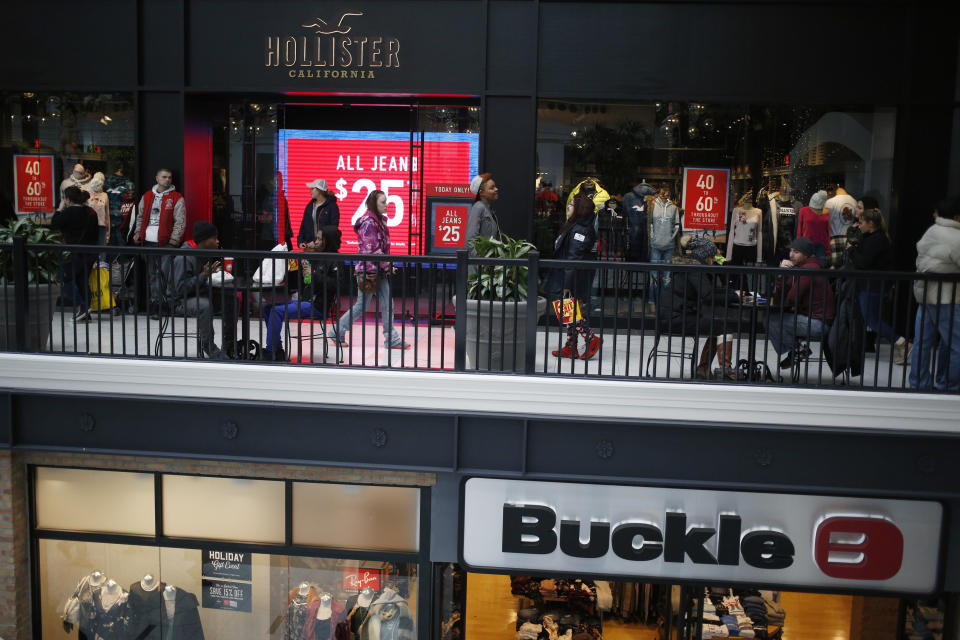Abercrombie & Fitch CEO has no plans to break up the company
The breakup of dusty, tired old specialty apparel brands that call the mall home is becoming the rage on Wall Street in a push to “unlock” shareholder value.
Just don’t think for a hot second that Abercrombie & Fitch (ANF) will join the seemingly cool crowd — mostly because it’s not a dusty or tired mall brand. Abercrombie & Fitch CEO Fran Horowitz tells Yahoo Finance she has no intention of breaking up Abercrombie & Fitch, which also owns the resurgent Hollister brand. Horowitz still sees strong value in operating as a portfolio of well known apparel brands.
Hey, it didn’t hurt to ask right? Remember, it was mid-2017 when Abercrombie & Fitch reportedly put itself on the sales block. The company ended that exploration process in July 2017.
Hollister carries Abercombie & Fitch
Hollister’s sales have been outperforming Abercrombie & Fitch for two years or so as it has sharpened prices and gotten better on apparel style for the always fickle young adult crowd.
Meanwhile, the Abercrombie & Fitch brand — while stabilizing from the disastrous final days of former long-time CEO Mike Jeffries amid an improvement in product quality and store experience — has struggled to drive consistent sales gains.
Same-store sales for Abercrombie & Fitch rose 1% in 2018 (dropped 2% in the fourth quarter). Hollister weighed in with an impressive 5% same-store sales gain for the year (6% increase for the quarter).

Horowitz shook up the company’s leadership team late last year, promoting former Hollister President Kristin Scott to oversee both brands. Horowitz says Scott’s influence on the Abercrombie & Fitch brand’s product assortments will start to show up shortly in stores — with a greater influence appearing later this year.
Theoretically, the value of Abercrombie & Fitch may be held back by the up and down performance of its namesake division. So why not list Hollister as a public company to maximize the strong performance of the brand?
Horowitz’s decision to stay the course on turning around both brands under one roof has been proven correct, however. Shares of Abercrombie & Fitch have skyrocketed 191% since July 2017, when it ended its reported sale discussions.
Other retail executives have not been so lucky as to stay the course on their various initiatives.
Gap makes the break, L Brands under pressure
After years of operational miscues — and the rise of even more competition in the apparel space — that have sent shoppers elsewhere, Gap’s board of directors has woken up to reality.
Gap disclosed recently that it would look to split up into two public companies by sometime in 2020. Old Navy — one of the strongest brands inside the Gap (GPS) portfolio — will be spun off into its own public company.
The remaining businesses named ‘NewCo,’ which will include Gap, Intermix, Athleta, Banana Republic, will live as its own separate entity. This holding company will house Gap’s generally slower growth brands.
Investors cheered the news as long overdue.
While not announcing a breakup, the bumbling management team at Victoria’s Secret owner L Brands (LB) is under fresh pressure to separate. Activist investor Barington Capital disclosed a small stake in L Brands this week and urged the company to sell off the rebounding Bath & Body Works.
L Brands’ management (despite founder/CEO Les Wexner owning about 17% of L Brands shares) has minimal arsenal to keep Barington at bay. Victoria’s Secret has lagged for years as executives have been reluctant to shift marketing away from size 0 models and become more competitive with undergarment prices. Victoria Secret’s Pink brand has been especially weak as it has missed out on the athleisure trend.
L Brands shares have tanked 47% over the past two years.
Brian Sozzi is an editor-at-large at Yahoo Finance. Follow him on Twitter @BrianSozzi
Read more:
